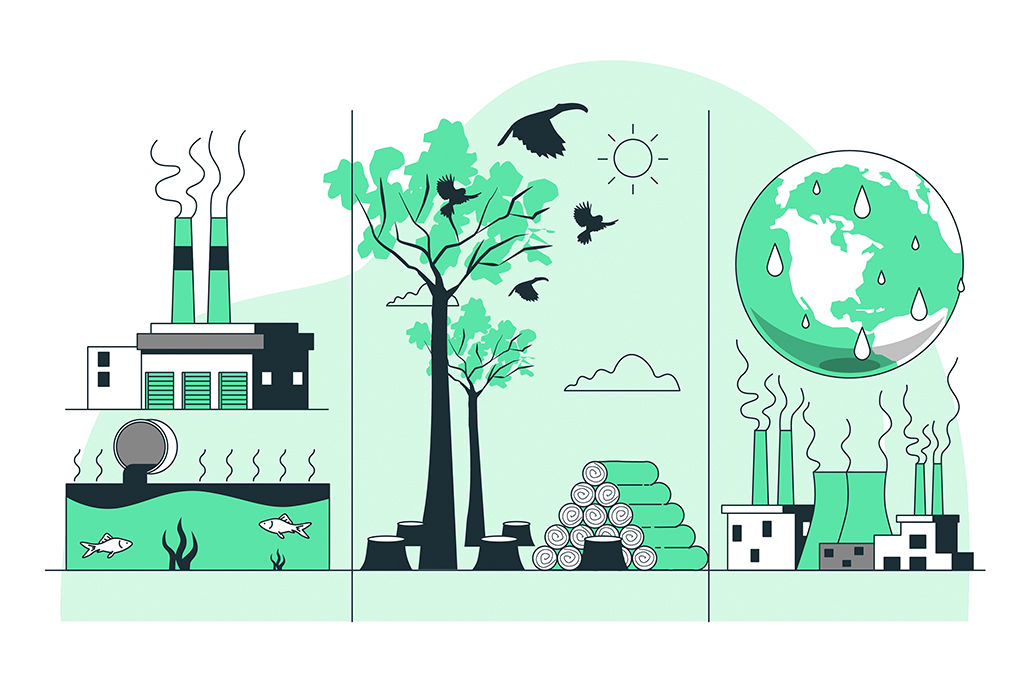Pressed by the unfolding climate crisis, field service leaders must take quick and more ambitious steps to act on sustainability concerns. One by one, firms will have to make appropriate adjustments to their operating models to shrink the carbon footprint and environmental impact of field service provision. How might that play out?
Author Teodora Gaici | Copperberg

Photo: Freepik
A push to stem climate change is now underway globally. The EU and US have set 2030 targets to cut emissions “by at least 55%” and respectively “50-52%”. Meanwhile, last November, the UN’s COP26 summit has had negotiators from 197 countries committing to reduce “global carbon dioxide emissions by 45% by 2030” under the Glasgow Climate Pact. But the biggest goal of all is to reach carbon neutrality around mid-century.
EU leaders have agreed on a Green Deal that opens up a way for Europe to become “the first climate-neutral continent” in 2050. Not long ago, the UK, too, has put forward an audacious plan to “achieve a 78% reduction” in emissions by 2035—hoping to transition to net-zero around 2050. Plus, China has declared its willingness to reach carbon neutrality before 2060.
Global climate targets have a direct impact on those who offer field services. Industry players everywhere have to bring sustainability to the fore of their agenda and lay a deeper focus on the sources of carbon emissions within field service sectors.
Read on to find out what field service leaders must do to deliver on the global climate agenda and how next-generation technology helps reach today’s carbon reduction targets.
The Time Has Come to Step Away From Traditional Field Service
The traditional field service activity makes an active contribution to harmful carbon pollution. Field technicians spend a significant part of their working day traveling in fleet vehicles to and between customer locations to provide in-person services. Many make repeat service visits to fix a problem. Plus, some technicians end up driving longer-than-expected distances due to firms still utilizing manual and inefficient methods to map out field service routes. Here is where a problem comes up. In the EU, “road transport accounts for around a fifth of carbon dioxide emissions,” according to data from the European Commission. Day after day, thousands of technicians spend a lot of time on the road and drive up emissions that stay in the atmosphere for years.
The urgency to tackle emissions from road travel is rising, but transportation is not the sole contributor to carbon pollution.
Once conventional workers return to the office, they often write their field reports using pen and paper. Then, a few continue to send and receive a lot of information through fax machines—which, on standby, produce “over 60,000 tonnes of carbon dioxide”. Paper is not a massive emitter of carbon dioxide; it is, in fact, responsible for 1.3% of global greenhouse gas emissions. Nevertheless, paper consumption impacts the environment and must be taken into account in climate action efforts.
As Carbon Emissions Go Up, So Should the Emphasis on Climate Action
Emissions of carbon dioxide, which have already hit a record high, will rise even further until everyone makes a greater effort to reduce the harmful pollutants resulting from work practices.
The transition toward net-zero emissions must be fast-tracked; that is the message The Glasgow Climate Pact has sent. It is an ambitious goal, yet world leaders present at COP26 have made it their mission to speed up net-zero plans. Over 110 firms have announced their commitment to switch to “fully zero-emission vehicle fleets by 2030”, signaling a readiness to accelerate the decarbonization of road transport. Many have also agreed to halt and reverse deforestation in pursuit of reduced emissions.
The agreements reached in Glasgow have drawn up the agenda for climate action. Field service leaders have to work now to establish more rigorous carbon neutrality targets. For the time being, firms must begin the transition to a low-carbon future. But they have to rush toward the goal of net-zero emissions. Mobilizing fast action to move forward with the climate agenda is unavoidable in averting a global environmental collapse.
Investment in Next-Generation Technology Puts Firms in a Great Position to Cut Emissions
The success of field service firms in meeting the climate challenge hinges on technology. Those who target environmental sustainability will find it necessary to invest in:
— Cutting-edge AI solutions to reduce technician travel time.
The use of AI for route optimization allows field technicians to reduce the number of kilometers driven by car to customer premises. Technology like AI makes it possible to identify the fastest route to the client’s location, but it can also predict traffic congestion a few hours in advance. Field workers utilizing real-time traffic information to plan and adjust routes can successfully avoid areas of heavy congestion and maximize fuel efficiency.
Moreover, advanced AI algorithms may predict failures before they happen and even empower systems to fix issues automatically through self-healing capabilities without technician intervention.
— AR-powered remote assistance to limit on-site visits.
Technicians can diagnose and fix equipment issues without making field visits. Through AR technology, professionals in the field service industry are well-equipped to visually guide customers in resolving technical issues. When complex on-site interventions are required, expert technicians with access to AR devices can remotely assist workers closest to the customer’s location in performing fieldwork; there is no need for long-distance travel.
— Top-notch field service management software to minimize paper consumption.
Firms seeking to reduce their carbon footprint have to make the paper to paperless transition. Field service management software offers many opportunities for industry players to digitize operations and, therefore, cut paper use. Compared to paper-based records, digital information is also more quickly accessible—helping reduce follow-up technician visits caused by limited or incomplete information.
Just a few countries have so far imposed legally-binding emission targets, but more are likely to introduce strict climate policies to support the net-zero transition. This makes it more urgent for industry leaders to embed net-zero within their field service operating models and invest in frontier technology to help curb climate change.






























